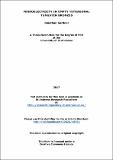Files in this item
Ferroelectricity in empty tetragonal tungsten bronzes
Item metadata
| dc.contributor.advisor | Morrison, Finlay | |
| dc.contributor.author | Gardner, Jonathan | |
| dc.coverage.spatial | [14], 187 p. | en_US |
| dc.date.accessioned | 2017-04-06T15:17:31Z | |
| dc.date.available | 2017-04-06T15:17:31Z | |
| dc.date.issued | 2017-06-21 | |
| dc.identifier | uk.bl.ethos.707268 | |
| dc.identifier.uri | https://hdl.handle.net/10023/10592 | |
| dc.description.abstract | In this work, in-depth structural and electrical characterisation is used to study a family of “empty” tetragonal tungsten bronzes (TTBs), A2₄A1₂B1₂B2₈O₃₀. An initial investigation into the effect of the A1-cation size on the properties of empty Ba₄R₀.₆₇◻₁.₃₃Nb₁₀O₃₀ TTBs (where R is the A1-cation and R = La, Nd, Sm, Gd, Dy and Y; ◻ = vacancy) was performed. These were determined to be metrically tetragonal by powder x-ray diffraction, with decreasing R cation size inducing increased crystal anisotropy. This tetragonal structural distortion, driven by contraction in the ab-plane, is shown to stabilise c-axis ferroelectricity; a direct correlation between tetragonality and the ferroelectric Curie temperature, T[sub]C, is demonstrated. Further examination of the relaxor ferroelectric (RFE) to ferroelectric (FE) crossover in Ba₄(La₁₋ₓNdₓ)₀.₆₇◻₁.₃₃Nb₁₀O₃₀ TTBs using detailed structural studies employing variable temperature, high resolution neutron, synchrotron X-ray and electron diffraction revealed a common superstructure with 2√2 × √2 × 2 cell with respect to the basic tetragonal aristotype cell. However, they display different degrees of order/disorder which can disrupt polar order (ferroelectricity). La-rich analogues exhibit a disordered regime between the low and high temperature ferroelectric and non-polar phases. Although polar, this disordered regime is non-ferroelectric, however, large polarisation may be established with an applied electric field, but relaxes back to the disordered phase upon removal of the field. Substitution of Nd for La at the A1-site leads to destabilisation of the disordered phase and reintroduces “normal” ferroelectric behaviour. Finally, isovalent substitution of Sr²⁺∙ for Ba²⁺ is shown to lead to the development of relaxor behaviour at higher dopant concentrations in Ba₄₋ₓSrₓDy₀.₆₇◻₁.₃₃Nb₁₀O₃₀, (x = 0, 0.25, 0.5, 1, 2, 3; ◻ = vacancy). With increasing x the unit cell contracts in both the ab- plane and c-axis coinciding with a decrease in T[sub]C and development of relaxor behaviour for x ≥ 2. This observation is rationalised by differing cation occupancies: for x ≤ 1, Sr²⁺ principally occupies the A2-site while for x ≥ 2 significant Sr²⁺ occupation of the A1-site leads to the observed RFE characteristics. The FE to RFE crossover is discussed in the context of a previously proposed TTB crystal chemical framework with the A1-site tolerance factor identified as the dominant influence on relaxor behaviour. | en_US |
| dc.language.iso | en | en_US |
| dc.publisher | University of St Andrews | |
| dc.rights | Attribution-NonCommercial-NoDerivatives 4.0 International | * |
| dc.rights.uri | http://creativecommons.org/licenses/by-nc-nd/4.0/ | * |
| dc.subject | Ferroelectric | en_US |
| dc.subject | Dielectric | en_US |
| dc.subject | Relaxor | en_US |
| dc.subject | Structural disorder | en_US |
| dc.subject | Powder neutron diffraction | en_US |
| dc.subject | Powder X-ray diffraction | en_US |
| dc.subject | Tetragonal tungsten bronze | en_US |
| dc.subject | Structure-property | en_US |
| dc.subject.lcc | QD181.W1G2 | |
| dc.subject.lcsh | Ferroelectricity | en |
| dc.subject.lcsh | Tungsten bronze | en |
| dc.title | Ferroelectricity in empty tetragonal tungsten bronzes | en_US |
| dc.type | Thesis | en_US |
| dc.contributor.sponsor | Engineering and Physical Sciences Research Council (EPSRC) | en_US |
| dc.type.qualificationlevel | Doctoral | en_US |
| dc.type.qualificationname | PhD Doctor of Philosophy | en_US |
| dc.publisher.institution | The University of St Andrews | en_US |
The following licence files are associated with this item:
This item appears in the following Collection(s)
Except where otherwise noted within the work, this item's licence for re-use is described as Attribution-NonCommercial-NoDerivatives 4.0 International
Items in the St Andrews Research Repository are protected by copyright, with all rights reserved, unless otherwise indicated.


